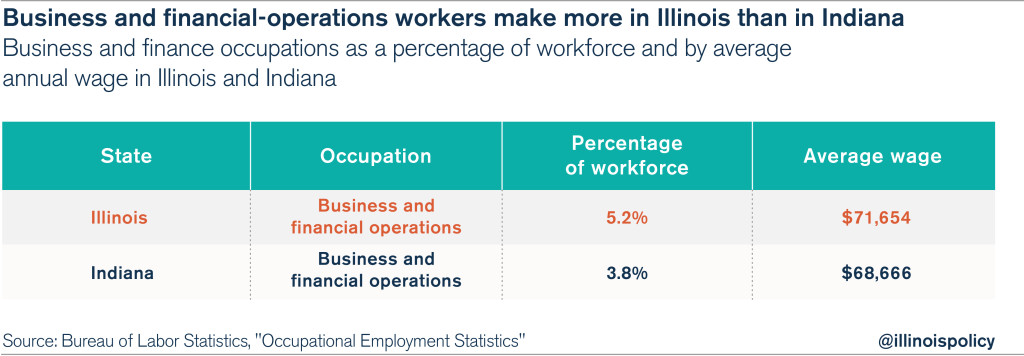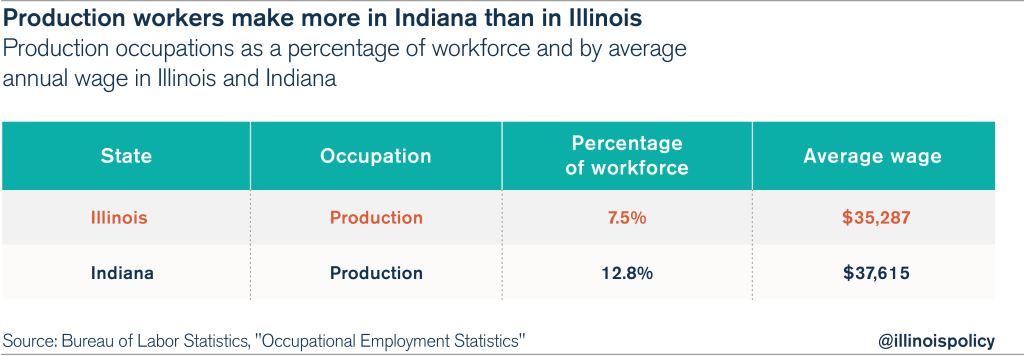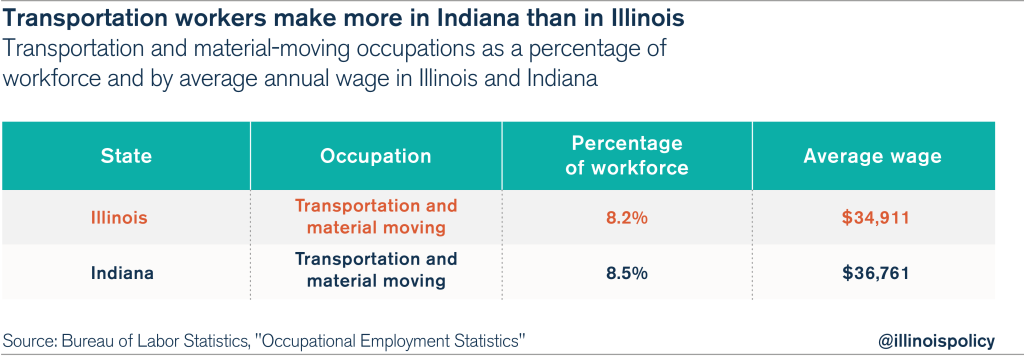Wage difference: Illinois is a hub for white-collar jobs, but blue-collar workers are better off in Indiana
Recent federal jobs data show that white-collar professionals are more numerous and earn more money in Illinois than in Indiana, but that Indiana, a Right-to-Work state, has more and better-paying jobs for blue-collar workers than does Illinois, which has forced unionization.
Illinois has slightly higher wages, on average, than Indiana. According to the most recent comprehensive data from the Bureau of Labor Statistics, or BLS, the average wage in Illinois is $48,297 per year compared to $45,372 in Indiana, after adjusting for purchasing power. But looking at the difference between wages in Illinois and wages in Indiana is not an apples-to-apples comparison, as Indiana and Illinois comprise two completely different industrial and occupational environments. Illinois is a place where top earners make more, but Indiana offers better pay for blue-collar workers.
The average Illinoisan earns more money because Illinois has more CEOs, chief financial officers and other white-collar professionals, according to BLS data, and these professionals are usually better paid in Illinois than in Indiana. On the other hand, Indiana has a larger portion of its workforce in blue-collar professions, and Indiana’s blue-collar workers are usually better paid than Illinois’ blue-collar workers.
Executives make more in Illinois. But production workers make more in Indiana.
This turns the Right-to-Work myth on its head – specifically, that Right to Work is bad for middle-class workers. Right-to-Work critics would never argue that Indiana’s Right-to-Work law causes Indiana to have better-paid transportation workers and factory workers, but worse-paid CFOs and lawyers. Nor would critics of Right to Work argue that Illinois needs to preserve its forced-unionization status in order to protect the high pay of CEOs and ensure the lower pay and worse job prospects of production workers.
Management vs. manufacturing: Breaking down the numbers in Indiana and Illinois
Management occupations make up 6.4 percent of total employment in Illinois, compared to only 4.5 percent of total employment in Indiana. Not only does Illinois have a larger portion of its workforce in management occupations, but managers make more in Illinois than in Indiana. The average manager in Illinois takes home $4,000 more than the average manager in Indiana, even after adjusting for the cost of living.
The same holds true for workers in business and financial operations. Illinois has 5.2 percent of its workforce in business and finance occupations, compared to 3.8 percent in Indiana. And in Illinois, these workers earn about $3,000 more per year than their peers in Indiana.
Legal professionals also constitute a greater percentage of Illinois’ workforce than Indiana’s and earn higher salaries in Illinois than they do in Indiana. The average person in this line of work earns $16,000 more per year in Illinois than in Indiana.
But what about blue-collar occupations? Has Illinois’ forced unionization boosted the wages of factory workers, truck drivers and food-service workers? Actually, the opposite has happened. Blue-collar workers on the whole earn more in Indiana than in Illinois.
Production workers, who are largely factory workers, are much more common in Indiana than in Illinois, and Indiana’s production workers take home $2,300 more per year than Illinois’ production workers. So much for Right to Work driving down the wages of factory workers.
Transportation and material-moving workers are about equally represented in Illinois and in Indiana. But the Hoosier worker in this field earns $1,850 more than his counterpart in Illinois in annual wages after adjusting for the cost of living.
Even food-service workers do better in Indiana than in Illinois, taking home an additional $600 per year. Advocates of Illinois’ forced unionization would say this policy helps food-service workers obtain higher wages, but that does not reflect the situation for Illinois and Indiana residents in this line of work.
Other occupations that make up a significant percentage of blue-collar employment such as installation, maintenance and repair, and office and administrative support, have roughly equivalent wages between the two states. The only blue-collar jobs sectors in which Illinois workers make substantially more than Indiana workers are construction and extraction, and protective services. This is largely driven by Illinois’ prevailing-wage law, which mandates certain wage rates and benefits for workers on publicly funded construction projects, and public-sector salaries. However, even without a prevailing-wage law, Indiana has a larger percentage of its workforce in construction, and Hoosier construction workers are still the seventh-highest paid in the country.
One of the biggest myths about Right-to-Work laws is that they cause wages and incomes to fall. However, Indiana’s and Michigan’s experiences after they enacted Right to Work belie that notion: Not only did their residents’ personal incomes not plummet, they actually rose faster than personal income in Illinois. Those who say Illinois should not adopt Right-to-Work policies because they will cause incomes to fall are ignoring the facts.
Moreover, workers in the very industries that should be impacted by unionization – such as production, transportation and food services – are actually doing better in Right-to-Work Indiana than in forced-unionization Illinois.
Lawmakers who want better job opportunities and wages for less-skilled and blue-collar workers should consider this: Indiana is outperforming Illinois for both of these groups. Indiana’s pro-growth environment provides blue-collar and less-skilled workers better job opportunities and higher wages, while Illinois’ anti-growth policies hold down incomes for these workers and suppress job creation.






